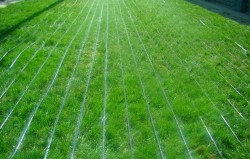 Drip irrigation has enabled farmers, nurserymen, and landscapers to conserve water for decades. This is primarily because, in contrast to gravity or sprinkler irrigation, drip irrigation technology applies water slowly and directly to the targeted plant's root zone. In addition, drip irrigation technology has extremely high application uniformity, even when pressures vary from hilly terrain or long lengths of run, or where planted areas are oddly shaped.
Water is conserved in the following ways:
- Drip irrigation application uniformity is very high, usually over 90%.
- Unlike sprinklers, drip irrigation applies water directly to the soil, eliminating water loss from wind.
- Application rates are low so water may be spoon fed to the crop or plant root zone in the exact amounts required (even on a daily or hourly basis). In contrast, other methods entail higher water application quantities and less frequency. If young plants need water frequently, much of the water applied is often wasted to deep percolation or runoff.
- Low application rates are less likely to run off from heavier soils or sloping terrain.
- Drip irrigation does not water non-targeted areas such as furrows and roads in agriculture, between beds, blocks or benches in greenhouses, or hardscape, buildings or roads in landscape.
- Drip irrigation easily adapts to odd-shaped planting areas which are difficult to address with sprinklers or gravity irrigation.
- Drip irrigation is capable of germinating seeds and setting transplants which eliminates the need for "sprinklering up" and eliminates the resulting waste in the early stages of crop growth.
|

